Abstract
The Fe/FeAl2O4 cermet was prepared with Fe-Fe2O3-Al2O3 powder by a hot press sintering method at 1400 °C. The raw materials for the powder particles were respectively 2 µm (Fe), 0.5 µm (Fe2O3), and 0.5 µm (Al2O3) in diameter, the sintering pressure was 30 MPa, and the holding time was 120 min. The effects of different Fe mass ratios on the microstructure and mechanical properties of Fe/FeAl2O4 cermet were studied. The results showed that a new ceramic phase FeAl2O4 could be formed by an in situ reaction during the hot press sintering. When the Fe mass ratio was increased, the microstructure and mechanical properties of the Fe/FeAl2O4 cermet showed a change law that initially became better and then became worse. The best microstructure and mechanical properties were obtained in the S2 sample, where the mass ratio of Fe-Fe2O3-Al2O3 was 6:1:2. In this Fe mass ratio, the relative density was about 94%, and the Vickers hardness and bending strength were 1.21 GPa and 210.0 MPa, respectively. The reaction mechanism of Fe in the preparation process was the in situ synthesis reaction of FeAl2O4 and the diffusion reaction of Fe to FeAl2O4 grains. The increase of the Fe mass ratio improved the wettability of Fe and FeAl2O4, which increased the diffusion rate of Fe to FeAl2O4 grains, which increased the influence on the structure of FeAl2O4.
1. Introduction
Iron-based cermet has the high hardness of ceramics, good thermal stability, good wear resistance, corrosion resistance, as well as metals’ thermal conductivity and toughness [1,2,3,4]. It has mainly been used in aviation, automotive, and petroleum engineering, as well as engineering in machinery such as brakes or clutches [5,6,7,8,9]. The low raw material cost of iron-based cermet greatly reduces the preparation cost and promotes the wide application of metal-based ceramics. Fe has relatively good wettability with carbides such as TiC, VC, WC, ZrC, and Cr3C2. Therefore, there have been many studies conducted on iron-based cermet with carbides as reinforcements [10,11,12,13]. However, its high price limits its use in a wide range of applications. In recent years, research on iron-based cermet using inexpensive and widely sourced Fe and Al2O3 as the main raw materials has seen some development.
Bansal [14] studied the interface bonding between Fe and Al2O3 due to the formation of spinel phase FeAl2O4, which improves the wettability of metal and ceramic phases. Konopka [15] investigated the influence of Fe content on the microstructure and fracture toughness of iron-based cermet, and found that the fracture toughness of Fe/Al2O3 cermet depended on the Fe content and the formation of FeAl2O4 during the sintering process, as well as the formation of FeO around the iron particles. The formation of micro-crack defects between FeAl2O4 and Fe led to passivation of the external stress of the cermet, which led to splits and deflections in the cracks. Other studies have found that the fracture toughness of the cermet improved as the amount of FeAl2O4 was increased [16,17]. The above studies demonstrate that metallic Fe has an important influence on the performance of iron-based cermet. Gupta [18,19,20,21] used Fe and Al2O3 (5–30 wt%) to prepare iron-based cermet by powder metallurgy, and found that the iron-based cermet prepared with 5 wt% Al2O3 and 95 wt% Fe had the lowest total surface wear. Shuai Li [22] prepared iron-based cermet with low-grade bauxite powder and reduced iron powder, and found that with increasing Fe content, the compactness of the cermet increased, the volume density increased, and the water absorption rate and microporosity decreased; compressive strength and bending strength also had a greater impact.
In this study, hot pressing and sintering were used to add a reinforcing Fe2O3 phase to the Fe/Al2O3 system, and FeAl2O4 was formed by the in situ reaction of Fe, Fe2O3, and Al2O3 to improve the wettability between Fe and the ceramic phase. The metallic Fe phase changed from solid phase to liquid phase during the hot pressing sintering process. This would promote the fluidity of the metallic phase in the ceramic phase and affect the material transfer process, and then further affect the structure and mechanical properties of the Fe/FeAl2O4 cermet. Therefore, determining the law of Fe’s influence on the microstructure and mechanical properties of Fe/FeAl2O4 cermet was one of the key links to preparing an Fe/FeAl2O4 cermet with excellent performance. In addition, Fe, Al2O3, and Fe2O3 are inexpensive and have a wide range of sources. Currently, they are the main components of metallurgical solid waste, such as zinc slag, steel slag, and red mud. This work could provide an important theoretical basis for the comprehensive utilization of metallurgical solid waste [23,24].
2. Materials and Methods
The raw materials in this experiment were analytically pure Fe powder (2 µm), Fe2O3 powder (500 nm), and Al2O3 powder (500 nm). The raw material ratios of the five sintered samples are shown in Table 1. The ingredients were obtained according to the ratio in Table 1. Absolute ethanol was used as the dispersion medium, and a XQM-2 vertical planetary ball mill was used for ball milling. The ball milling speed was 300 r/min, and ball milling time was 10 h. After ball milling, the samples were placed in a DZF-6050 vacuum drying oven at 120 °C for 24 h, and the vacuum was pumped to 100 Pa during drying. After drying, the mixed powder was passed through a 200-mesh sieve and put into a ZT-40-21Y high-temperature hot press sintering furnace to prepare the Fe/FeAl2O4 at 1400 °C and 30 MPa for 120 min, and the vacuum was pumped to 10−2 Pa during sintering.

Table 1.
Chemical composition with different Fe proportion for each sample (wt%).
The relative density of the prepared samples was measured by the Archimedes principle, the bending strength was measured using the three-point bending method with a CMT4202 universal material testing machine with a crosshead speed of 0.5 mm/min and span of 30 mm, and the Vickers hardness was measured at a loading force of 49.05 N (5 kg) for 10–15 s by Tukon2500 Vickers hardness tester. Phase and composition analysis (XPert PRO MPD, PANalytical, The Netherlands) was carried out with an X-ray diffractometer. The microstructure and element analysis were carried out with SEM and EDS (GeminiSEM 300, Zeiss, Germany), respectively.
3. Results and Discussion
3.1. Preparation Principle of Fe/FeAl2O4 Cermet
Using the analysis of thermodynamic software FactSage, it was shown that Fe, Fe2O3, and Al2O3 powder can spontaneously synthesize FeAl2O4 through an in situ reaction under the experimental conditions, in the following Equation (1):
Due to the excessive Fe content in the mixed powder of ingredients, Fe2O3 and Al2O3 reacted completely after the in situ reaction and the Fe became redundant. The FeAl2O4 produced by the in-situ reaction combined with the redundant metal Fe, and the Fe/FeAl2O4 cermet was prepared during the process of hot pressing and sintering. The in situ reaction occurred on the three-phase interface of Fe liquid, Fe2O3, and Al2O3. This was an interface reaction-driven wetting, according to the free energy change control theory of interface reaction proposed by Aksay [25], as shown in Equation (2):
where is the solid/liquid interface energy before the reaction, A is the interface area, and is the free energy change produced by the interface reaction product per unit volume. According to Aksay [25], the decrease of free energy in the interfacial reaction is the main driving force controlling the wetting process. The improvement of wettability is caused by the decrease of free energy. The interfacial reaction is more intense, is lower, and the wettability of the system is better. For Reaction (1), with increasing Fe content in the raw material, the in situ reaction for the synthesis FeAl2O4 would be more intense, and the wettability between liquid Fe and FeAl2O4would be better. With the wetting of Fe and FeAl2O4, the increased concentration gradient of Fe would increase the diffusion rate of Fe to FeAl2O4 grains. The change law states that Fe accumulates in the FeAl2O4 grains as they grow, which has a greater impact on the structure of FeAl2O4 at the macro level, and this is reflected in changes in microstructure and mechanical properties.
The FactSage thermodynamic software was used to draw the phase diagram of the Fe-Fe2O3-Al2O3 ternary system under these experimental conditions, and the composition design included samples S1, S2, S3, S4, and S5, as shown in Figure 1.
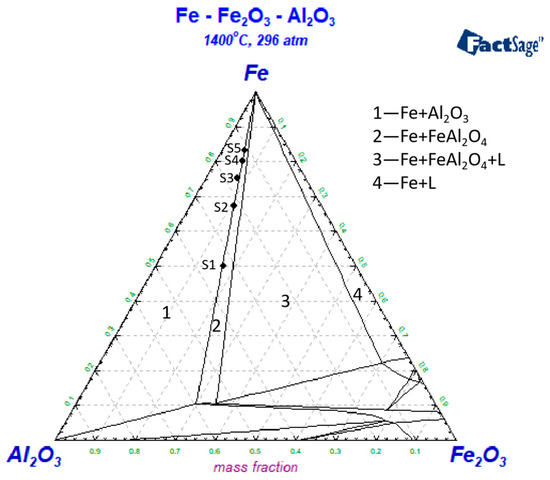
Figure 1.
Fe-Fe2O3-Al2O3 phase diagram at 1400 °C.
Figure 2 shows the XRD results of the hot press sintering of samples. The results show that the phase composition of each sample was metal phase Fe and FeAl2O4. The above results are consistent with the results of theoretical thermodynamic calculations and indicate that an in situ reaction occurred in the interface between liquid Fe, Fe2O3, and Al2O3 during the hot press sintering process.

Figure 2.
XRD patterns of the Fe/FeAl2O4 composites.
Figure 3 show the mass faction of Fe phase and FeAl2O4 phase calculated by FactSage in the prepared Fe/FeAl2O4 cermet. The results show that there were only the Fe phase and the FeAl2O4 phase in the prepared samples under the experimental ratios. With the increase of Fe content, the relative content of Fe phase and FeAl2O4 phase in the prepared Fe/FeAl2O4 cermet showed an upward and downward trend, respectively. This is consistent with the results of the XRD.
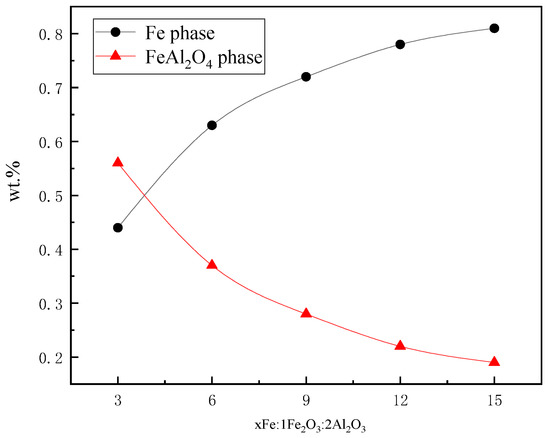
Figure 3.
Mass fraction of phases in composites.
3.2. Effect on Microstructure
Figure 4 shows the fracture structure of different samples, which could characterize the combination of the metal phase and ceramic phase to a certain extent. The fracture of the Fe/FeAl2O4 cermet was mainly intergranular. With the increase of Fe, the microstructure of samples S1–S5 changed significantly. The bonding effect among the grains in S1 was poor, a large number of grain boundaries were exposed, and relatively more pores appeared. The section of the sample in S2–S4 became dense, the grains grew significantly, and the bonding effect among the grains was significantly improved. In S2–S4, the pores were reduced, but slight cracks appeared in S4. The surface in S5 was powdered, the crystal grains were obviously smaller, and more pores appeared. The change rule of the microstructure was consistent with the conclusions of Aksay’s interface reaction free energy change control theory [25]. The increase of Fe affected the physical and chemical reactions in the hot press sintering process. On the one hand, it promoted the in situ reaction, reduced the interfacial energy of the solid/liquid surface, and improved the wettability of Fe and FeAl2O4. On the other hand, it increased the concentration gradient of Fe on the interface between Fe liquid and FeAl2O4, and increased its diffusion rate.
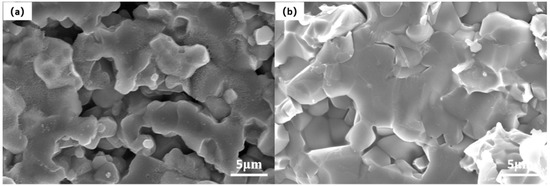
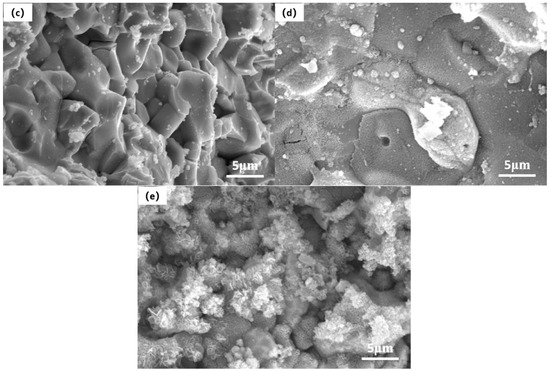
Figure 4.
SEM micrographs of the fracture surface of Fe (bright area)/FeAl2O4 (dark area) composites: (a) S1; (b) S2; (c) S3; (d) S4; (e) S5.
The analysis results of the point scan and the surface scan of the fracture energy spectrum in S2 are shown in Figure 5 and Figure 6. The spot scanning showed that the grain at the spot was FeAl2O4. The surface scanning showed that the bright area was the Fe phase, and the dark area was the FeAl2O4 phase. This result is completely consistent with the XRD results. Fe, Al, and O were distributed in the whole area, and as a result of the combined point scanning, FeAl2O4 existed in the whole area. In the area where FeAl2O4 was evenly distributed, there was a concentrated area of Fe, which indicated that metal Fe diffused into the FeAl2O4 grains during the in situ reaction. The material transferred between FeAl2O4 and Fe indicated that the wetting process followed the reaction-driven wetting mechanism. The increase of Fe liquid increased the reaction driving force, which improved the wettability between the two phases. This agrees with the interface reaction free energy change control proposed by Aksay’s [25].
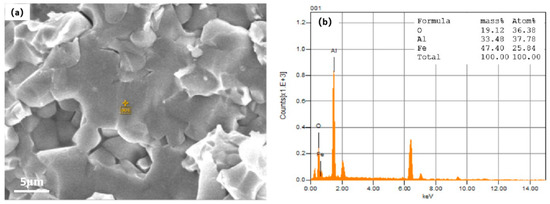
Figure 5.
EDS analysis of FeAl2O4 phase with Fe:Fe2O3:Al2O3 at 6:1:2: (a) SEM photographs of S2; (b) EDS of point.

Figure 6.
Mapping analysis for the major elements (Fe, Al, O) of Fe/FeAl2O4 composites with Fe:Fe2O3:Al2O3 at 6:1:2: (a) O; (b) Al; (c) Fe.
3.3. Effect on Mechanical Properties
The relative density, Vickers hardness, and bending strength of Fe/FeAl2O4 cermet with different proportions were analyzed, as shown in Figure 7. The increased Fe content increased the relative density of the Fe/FeAl2O4 cermet, which remain at about 94% after sample S2. This experimental result is consistent with the SEM result in Figure 4, which shows that the porosity of Fe/FeAl2O4 cermet increased from S1 to S2, and the porosity of S2–S5 remained unchanged. The Vickers hardness of Fe/FeAl2O4 cermet first increased and then decreased with the increase in Fe content. The bending strength first increased and then decreased with the increase in Fe content. The Vickers hardness and bending strength reached their maximum values in S2 (1.21 GPa and 210.0 MPa, respectively). The effect of Fe on the microstructure and mechanical properties of Fe/FeAl2O4 cermet was caused by the wetting process between Fe liquid and FeAl2O4. According to Aksay’s theory [25], the increase in Fe content effectively improved the wettability of Fe and FeAl2O4, not only improving the bonding ability of Fe and FeAl2O4, but also providing a favorable channel for the diffusion of Fe to FeAl2O4, and promoting the compactness, Vickers hardness, and bending strength of cermet. However, with the further increase in Fe content, the diffusion rate of Fe to FeAl2O4 increased, and Fe continued to accumulate in the growing FeAl2O4 grains, eventually leading to the collapse of the FeAl2O4 structure. Therefore, the increase in Fe was conducive to the improvement of the mechanical properties of the Fe/FeAl2O4 cermet to a certain extent, but too much Fe aggravated the reaction and wetting on the interface between Fe and FeAl2O4, and affected the structure of FeAl2O4. Macroscopically, cracks and evenly distributed powdering appeared on the surface. This is consistent with the results in Figure 4.

Figure 7.
Effects of Fe on the bending strength, relative density and Vickers hardness in Fe/FeAl2O4 cermet.
The influence law of Fe relative to the Fe/FeAl2O4 cermet’s structure and mechanical properties is consistent with Aksay’s interface reaction free energy change control theory [25]. The reaction mechanism of the Fe/FeAl2O4 cermet prepared by hot press sintering was obtained as shown in Figure 8. As the content of Fe increased, the in situ synthesis Reaction (1) was intensified, so that the wettability between liquid Fe and FeAl2O4 was improved. After breaking the wetting barrier between Fe and FeAl2O4, with the increase of Fe, the diffusion rate of Fe to FeAl2O4 grains increased, and it accumulated as the FeAl2O4 grains grew. The continuous accumulation of Fe in the FeAl2O4 grains increased the impact on the FeAl2O4 structure, eventually leading to the collapse of the FeAl2O4 structure. Therefore, increasing Fe was conducive to improving the wettability between Fe and FeAl2O4, however, too much Fe affected the structure of FeAl2O4 and resulted in poor mechanical properties. In this study, the optimum Fe:Fe2O3:Al2O3 ratio was 6:1:2.

Figure 8.
Reaction mechanism of Fe in preparation of Fe/FeAl2O4 cermet by hot press sintering.
4. Conclusions
In this paper, Fe/FeAl2O4 cermet in different Fe phases was prepared by hot press sintering, and the following conclusions were obtained.
(1) With the increase of Fe, the diffusion of Fe into FeAl2O4 grains occurred; the density of Fe/FeAl2O4 cermet increased, the grains of FeAl2O4 continued to grow, and the bonding ability of Fe and FeAl2O4 increased. However, the ratio of Fe:Fe2O3:Al2O3 was 12:1:2 and 15:1:2, the bonding ability of Fe and FeAl2O4 was decreased, cracks and evenly distributed powdering appeared on the cermet.
(2) With the increase of Fe, the relative density of Fe/FeAl2O4 cermet first increased and then remained stable. The Vickers hardness and bending strength first increased and then decreased. The relative density of the cermet was maintained at about 94%, with a Fe:Fe2O3:Al2O3 ratio of 6:1:2. The Vickers hardness and bending strength reached a maximum of 1.21 GPa and 210.0 MPa, respectively.
(3) The reaction mechanism of Fe/FeAl2O4 cermet prepared by hot press sintering contained an in situ reaction synthesis to FeAl2O4 and a Fe diffusion reaction to FeAl2O4 grains. An increase of Fe improved the wettability between Fe and FeAl2O4, and increased the diffusion rate in the growing FeAl2O4 grains. The Fe continued to accumulate and strengthen in the FeAl2O4 grains. The effect on the structure of FeAl2O4 was macroscopically expressed as the phenomenon that the mechanical properties of Fe/FeAl2O4 cermet improved initially, and then became worse.
Author Contributions
K.Z. and C.W. conceived and designed the experiments; Y.L. and H.Y. analyzed the data; H.Y. wrote the paper; H.L. and J.L. guided the experiment; J.D. reviewed the paper. All authors have read and agreed to the published version of the manuscript.
Funding
This research was funded by the National Natural Science Foundation of China, grant number 51804126.
Institutional Review Board Statement
Not applicable for studies not involving humans or animals.
Informed Consent Statement
Not applicable for studies not involving humans.
Data Availability Statement
Not applicable.
Acknowledgments
This work was supported by the National Natural Science Foundation of China (No. 51804126).
Conflicts of Interest
The authors declare they have no conflict of interest. The funders had no role in the design of the study; in the collection, analysis, or interpretation of data; in the writing of the manuscript; or in the decision to publish the results.
References
- Shi, Z.L.; Du, X.K.; Li, C.A. Study on the iron base ceramic metal braking materials for high-speed train. J. China Railw. Soc. 2001, 23, 29–32. [Google Scholar]
- Wang, X.F.; Li, D.S. Iron-cermet friction materials for aircraft application. Mater. Eng. 1999, 3, 27–29. [Google Scholar]
- Rosso, M. Ceramic and metal matrix composites: Routes and properties. J. Mater. Process. Technol. 2006, 175, 364–375. [Google Scholar] [CrossRef]
- Chen, W.P.; Yang, S.F.; Han, M.Y. Research development of ceramic/Fe-based alloy composites. Chin. J. Nonferrous Met. 2010, 20, 257–265. [Google Scholar]
- Reshetenko, T.V.; Avdeeva, L.B.; Khassin, A.A.; Kustova, G.N.; Ushakov, V.A.; Moroz, E.M.; Shmakov, A.N.; Kriventsov, V.V.; Kochubey, D.I.; Pavlyukhin, Y.T. Coprecipitated iron-containing catalysts (Fe-Al2O3, Fe-Co-Al2O3, Fe-Ni-Al2O3) for methane decomposition at moderate temperatures I. Genesis of calcined and reduced catalysts. Appl. Catal. A 2004, 268, 127–138. [Google Scholar] [CrossRef]
- Li, M.C.; Gong, Q.; Yang, Y.Q.; Yu, J.; Zhou, Y.; Zuo, X.Q. Structures and properties of Al2O3/Fe composite honeycombs fabricated by plasticizing powder extrusion. Acta Mater. Compos. Sin. 2016, 33, 2237–2245. [Google Scholar]
- Ma, J.J.; Hou, Y.G.; Li, G.F.; Tian, J.; Zhou, Q.; GAO, Y. Effect of Co on performance and structure of low-temperature Fe-based ceramic/metal composite bonds. Diam. Abras. Eng. 2016, 36, 61–65. [Google Scholar]
- Zhu, L.; Bolot, R.; Liao, H. Formation mechanism of Fe-Al2O3-FeAl2O4 and FeAl coating by reactive plasma spraying under atmosphere and low pressure conditions. Asm Int. 2013, 5, 13–15. [Google Scholar]
- Liu, J.F.; Wang, Z.; Ding, Y.S. Research on the combined properties of Fe/Al2O3 graded coatings. Chin. J. Mater. Res. 2010, 24, 401–405. [Google Scholar]
- Wang, J. Study on wear-resistance of TiC-Fe matrix composite produced by powder metallurgy. Mater. Heat Treat. 2008, 37, 50–52. [Google Scholar]
- Liu, J.W.; Ding, H.F.; Zheng, Z.X. Study on technological parameters and properties of sintered SiCp/Fe composite material. Min. Metall. Eng. 2002, 22, 92–95. [Google Scholar]
- Farid, A.; Guo, S.J.; Jawid, A.; Tian, J. Sintering behavior, microstructure and properties of TiC-FeCr hard alloy. J. Univ. Sci. Technol. Beijing 2007, 14, 89–93. [Google Scholar]
- Srivastava, A.K.; Das, K. Microstructure and abrasive wear study of (Ti, W) C-reinforced high-manganese austenitic steel matrix composite. Mater. Lett. 2008, 62, 3947–3950. [Google Scholar] [CrossRef]
- Bansal, C. Metal-to-ceramic bonding in (Al2O3+Fe) cermet studied by Miissbauer spectroscopy. Bull. Mater. Sci. 1984, 6, 13–16. [Google Scholar] [CrossRef]
- Konopka, K.; Ozieblo, A. Microstructure and the fracture toughness of the Al2O3-Fe composites. Mater. Charact. 2001, 46, 125–129. [Google Scholar] [CrossRef]
- Wang, Z.; Liu, J.F.; Ding, Y.S. Fabrication and Properties of Fe/Al2O3 Composites. Chin. J. Mater. Res. 2012, 26, 206–210. [Google Scholar]
- Konopka, K. Shape, size and distribution of metal particles embedded in a ceramic matrix. Solid State Phenom. 2015, 231, 57–63. [Google Scholar] [CrossRef]
- Gupta, P.; Kumar, D.; Parkash, O.; Jha, A.K. Structural and mechanical behavior of 5% Al2O3 reinforced Fe metal matrix composites (MMC) produced by powder metallurgy (P/M) route. Bull. Mater. Sci. 2013, 36, 859–868. [Google Scholar] [CrossRef]
- Gupta, P.; Kumar, D.; Parkash, O.; Jha, A.K. Sintering and hardness behavior of Fe-Al2O3 metal matrix nanocomposites prepared by powder metallurgy. J. Compos. 2014, 2014, 1–10. [Google Scholar] [CrossRef]
- Garg, P.; Gupta, P.; Kumar, D.; Parkash, O. Structural and mechanical properties of graphene reinforced aluminum matrix composites. J. Mater. Env. Sci. 2016, 7, 1461–1473. [Google Scholar]
- Gupta, P.; Kumar, D.; Parkash, O.; Jha, A.K. Effect of sintering on wear characteristics of Fe-Al2O3 metal matrix composites. Eng. Tribol. 2014, 228, 362–368. [Google Scholar] [CrossRef]
- Li, S.; Wu, W.F.; Chen, W.H.; Liu, J.; Ji, Y.H. Study on preparation and properties of Al2O3-Fe based metal ceramics. Appl. Mech. Mater. 2017, 865, 49–53. [Google Scholar] [CrossRef]
- Wang, C.; Zhang, K.; Yan, H.Y. Reuse of Zinc Kiln Slag to Fire Iron-based Cermet and its Prospect. Multipurp. Util. Miner. Resour. 2020, 4, 8–12. [Google Scholar]
- Wang, C.; Zhang, K.; Yan, H.Y. Strengthening Mechanism of Metal-based and Ceramic-based Cermet. China Ceram. 2020, 56, 1–4. [Google Scholar]
- Aksay, I.A.; Hoge, C.E.; Pask, J.A. Wetting under chemical-equilibrium and nonequilibrium conditions. J. Phys. Chem. 1976, 78, 1178–1183. [Google Scholar] [CrossRef]
Publisher’s Note: MDPI stays neutral with regard to jurisdictional claims in published maps and institutional affiliations. |
© 2021 by the authors. Licensee MDPI, Basel, Switzerland. This article is an open access article distributed under the terms and conditions of the Creative Commons Attribution (CC BY) license (http://creativecommons.org/licenses/by/4.0/).